Fig. 1.
Olfactory information is treated by two subsystems: signals from basiconic sensilla are processed in the T6 glomerular cluster, other olfactory cues within the main AL. Under the previous hypothesis, CHCs were specifically detected by 9-exon ORs (within basiconic sensilla), while other odorants (non-CHCs) were detected by non–9-exon ORs. Together with previous work (23), the new study by Slone et al. (7) shows that these are not exclusive categories and favors a combined model of ant social odor processing in which both subsystems process all odorants. Ant brain designed after Nishikawa et al. (24). CB, central body; LH, lateral horn; MB, mushroom bodies; OL, optic lobe.

